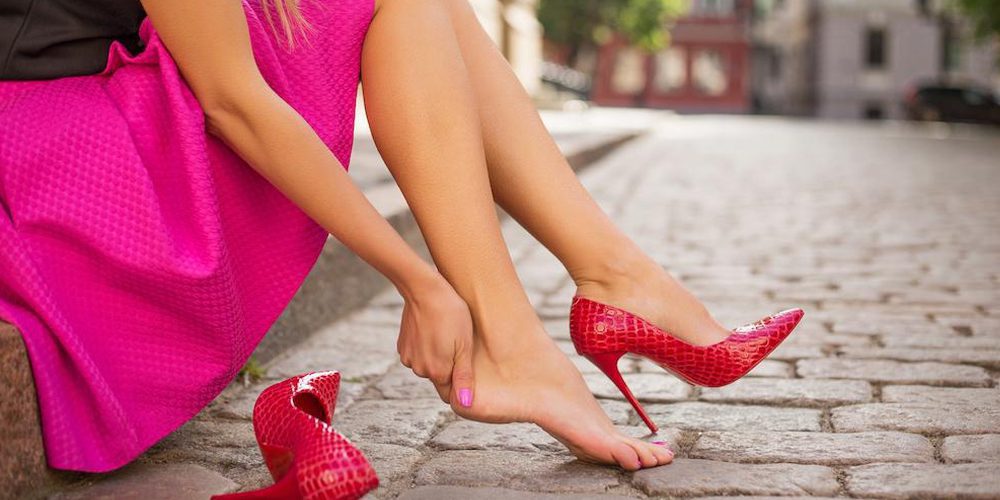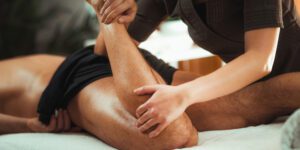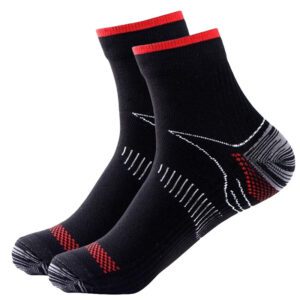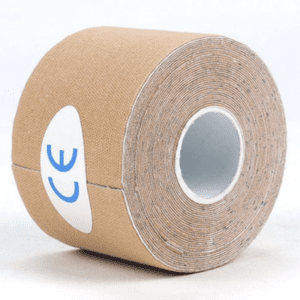Walking and jogging can put extra strain on your feet. We stuff our feet into tight-fitting, inflexible shoes, impose excessive angles on them with high heels, pound pavements and asphalt, smother them in socks and shoes or simply stand on them for hours on end. It’s no surprise that the skin, 26 bones, and a bunch of muscles and ligaments in your feet can’t stand the pressure at some times in our lives.
If you’ve had problems with your feet, such as corns or calluses, foot deformities, or if you aren’t feeling quite steady on your feet, you may want to have your shoe size measured. According to a recent study, just about 28% to 37% of people are actually wearing shoes that are the correct length and width. And this can lead to a lot of complications and even severe diseases.
What does ill-fitting shoes mean?
According to the dictionary, ill-fitting means that the shoes (or piece of clothing) don’t fit the person wearing them properly. Ill-fitting shoes can be too tight, too narrow, too wide, too firm or too loose. They may be too hard or too soft for the purpose you’re wearing them.
Men and women are both affected, but in a survey by the American Orthopedic Foot and Ankle Association (AOFAS), more than 75% of all women reported some kind of foot pain. That’s no surprise when you consider that the vast majority of them were wearing shoes that were smaller than their feet! Footwear that is too tight, too loose, airtight, comes in unnatural shapes can cause or exacerbate problems.
Over half of all women have had painful throbbing feet at some time in their life. Although an increase in standing or walking activity might be to blame, the problem is frequently ill-fitting shoes. Because the fat padding on the bottom of the feet dissipates with time, older women may find that this condition worsens with age.
What foot conditions can ill-fitting shoes cause?
Shoes are not only practical, but they’re also necessary for protecting your feet. Wearing shoes that are properly fitted can cushion the underfoot, maintain spine alignment, and make walking more pleasant in general. Common foot problems caused by ill-fitting shoes include:
- Athlete’s Foot. Athlete’s foot isn’t limited to long-distance runners or other athletes, as the name implies. The microscopic fungi that cause severe itching, burning, agony, and scaling on the toes or bottom of the foot are to blame. Bacteria, including germs and mold, can survive for weeks or even months on the moist surfaces of shower floors and sweaty socks or tight-fitting shoes.
- Blisters. Blisters are tiny bubbles on the skin that contain clear serum, although some blisters may also include blood. They’re generally caused by irritation and friction of the skin. If your new shoes don’t fit properly and rub against your toenail or heel, for example, they might cause skin blisters. Blisters are not a major health hazard. When you cease wearing tight, narrow shoes, the discomfort and swelling usually go away. If your feet blisters continue to get worse despite getting professional help, they might become infected.
- Bunions. It’s quite likely that you have a bunion if you’ve discovered an odd lump on the side of your foot at the base of your big toe. Bunions are caused when the base of the toe is pushed out of its normal position. This results in a bulge along one side of the foot that may be uncomfortable and inflamed. The big toe might put pressure on the second or even third toe as well. And that can lead to hammertoe, mallet toe or other foot deformities.
- Corns and Calluses. The skin builds hard layers of skin cells at the site of irritation as a defense against continual friction and pressure. The skin cells develop into spherical, kernel-like bumps known as corns. They’re generally found on top of or between toes. Calluses most often form on the sole, although they can also occur on other parts of the feet.
- Ingrown Toenails. The term “ingrown toenail” refers to a condition in which the toenails protrude and develop against the flesh beside them. Pain and inflammation are common results of overgrowth. Because ingrown toenails are a relatively minor issue, treatment will not stop unless you seek professional help. If you want faster results, skip the natural treatments and visit your podiatrist right away. With enough antibiotics, common foot ailments such as these will rapidly go away.
- Hammertoe and Mallet Toe. A hammertoe is a condition in which one of the smaller toes develops a claw-like appearance. The toe curls up instead of lying flat as a result of abnormalities in the toe joints, tendons, or muscles or nerves in the foot. Hammertoes are common among persons with diabetes. Wearing shoes that are too short can also induce this condition.
- Plantar Fasciitis. Plantar fasciitis is an inflammation of the plantar fascia, a thick band of tissues in the heel that runs from heel to toe. The plantar fascia becomes inflamed and causes striking heel pain that runs across the feet. Patients claim that taking their first steps when they wake up is excruciating. Plantar fasciitis is caused by a variety of factors, but the inflammation generally occurs in people who perform physical activities that put too much strain on their heels. (e.g., long-distance running). Furthermore, poor footwear fit that does not match your feet will magnify the danger.
How much room should be in the heel of a shoe?
The most important aspect of shoe fit is that they are well-fitting. They shouldn’t be too tight or too loose, to mention a few issues. Here are some pointers to ensure you get the ideal fit:
- Measure your feet. You can go into any foot store and get your feet measured. Alternatively, you can get yourself a measurement tool from sites like amazon. But a simple piece of paper and a pen does the trick too. Just stand tall on a sheet of paper and mark your big toe and heel. Then simply measure the length with a ruler and refer to the size chart of any shoe brand.
- Use your larger foot for sizing. Some of us have a larger foot on one side, so choose the shoe size that is most comfortable for this foot.
- Try shoes on both feet. You’ve decided on the best size for your larger feet, but try both shoes on to be sure they’re comfortable.
- Wear socks when trying shoes. If you would typically wear socks with this pair of shoes, try them on with the additional layer to see how they fit.
- Walk around while trying. If you’re unsure about the size, observe any rubbing or discomfort and compare it to a similar garment.
The easiest method to determine if a shoe is too big or too small is to check how much space there is in the toe of the footwear. There should be approximately one finger’s width of room between your longest toe and the end of the shoe.
Another method to verify this is to slide a finger between the heel of your foot and the heel of your shoe. There should be enough area for your finger to fit comfortably. If your finger fits easily with room to spare, you should probably go down half a size; if it’s a tight squeeze, you should go up half a size.
Can ill-fitting shoes cause plantar fasciitis?
Inflammation and pain in the plantar fascia ligament can be caused by flat feet, high arches, or physical activities such as jogging. This ligament connects the heel to the ball of your foot. Plantar fasciitis is the inflammation that results from this condition.
Plantar fasciitis is a type of heel pain that usually strikes after getting up in the morning or while being inactive for lengthy periods. Calcification of the fascia known as heel spurs can occur where it attaches to the heel, presenting with plantar fasciitis. Plantar fasciitis and heel spurs are caused by ill-fitting shoes, an abrupt increase in activity, or foot stress as a result of rapid weight gain.
In short, yes, ill-fitting shoes can cause plantar fasciitis.
What are the worst shoes for your feet?
Ill-fitting shoes restrict the feet. The increased pressure will start as mild discomfort, but continuous usage might result in toenail infections, skin abrasions, joint inflammation, and bone distortion. Here are the worst shoes for your feet:
- High Heels. Whether or not they’re sky-high, this style can create a painful knot in the heel. The hard material irritates a bony area known as a “pump bump” on some women, which is chronic. Blisters, edema, bursitis, and ache in the Achilles tendon are all consequences of wearing high heels too often and for too long.
- Ultra-high heels. High heels put a strain on the ball of the foot. A joint where the long metatarsal bones come into contact with the pea-shaped sesamoid bones and toe bones (phalanges) is known as a metatarsophalangeal joint. These bones or nerves can be inflamed by overzealous pressure. Hairline fractures may develop from chronic stress to the foot bones.
- Stilettos. The risk of falls and injuries is higher for women wearing stiletto heels than it is for other high heels, as the weight is concentrated on a tiny area. This might make you appear to be walking on stilts. You’ll have a greater chance of tripping and spraining your ankle.
- Flimsy shoes without arch support. Walking in flimsy shoes without adequate arch support can cause the plantar fascia to overstretch, tear, or inflame. This typical condition produces severe heel discomfort that improves for a short time when you rest your feet.
- Ballet Flats. These shoes are not designed to provide arch support. This can result in knee, hip, and back issues. Plantar fasciitis is a painful foot problem that may be caused by lack of arch support.
- Flip-Flops. Because they provide such little protection for your feet, you’re susceptible to cuts, splinters, and other foot problems. Furthermore, many flip-flops give no arch support. They may exacerbate plantar fasciitis and cause pain in the knees, hips, or back because they resemble ballet flats.
- Platform Shoes. The rigid foot beds of this design might make it difficult for your foot to move as it should when you walk. If the heel of the platform is significantly higher than the toe region, the shoe also applies pressure on the metatarsal bones.
- Pointy Toes. These don’t only look uncomfortable They squeeze your entire foot’s front together. This can cause nerve pain, bunions, blisters, and hammertoes over time. Some women develop bruises beneath their toenails from the constant pressure. This isn’t how your foot is designed to be.
- Wrong Sized Shoes. Women are wearing shoes that are too small, according to a new study. The results aren’t pretty: calluses, blisters, bunions, corns, and other issues may occur as a result of this. The rubbing can irritate the joints in the foot and cause arthritis.
- Barefoot Shoes. The main difference is that these shoes lack the benefits of a natural walking motion and design. There is no support or shock absorption built into them. In some brands, the shoes separate the toes, restricting your feet’ natural walking posture.
Is walking barefoot bad for your feet?
We put our feet’ biomechanical function and skin at risk when we walk barefoot. Even though many preceding generations walked barefoot, we should avoid doing so. Walking barefoot on hard surfaces puts a lot of strain on our feet, which can lead to significant stress for the rest of our bodies. When we walk, our feet naturally pronate (turn in), however when we go without shoes, we pronate for a longer time, changing the biomechanics and distribution of pressure and weight across the foot. Overpronation can lead to painful problems associated with excessive pronation, such as arch/heel pain, shin splints/posterior tibial tendonitis, and Achilles tendonitis. We often think of the arch as a support for our feet, but it can actually be a limitation. When we walk with an unbalanced load on one side of our body, this imbalance may translate up to other sections of the body, such as our knees and back. This is why after a long day spent barefoot or in shoes that don’t offer sufficient arch support, your feet may feel exhausted and sore.
Walking barefoot is not all bad. Walking barefoot on soft surfaces, such as carpeted flooring, grass, or sand, has advantages. Walking on these types of surfaces helps to improve circulation and nourishes the nerves, muscles, and bones in the foot. Walking barefoot may also help strengthen and stretch the muscles and ligaments of the foot, enhancing the function of the foot and lowering injuries. Walking barefoot on a clean, soft surface is perfectly healthy. So, go ahead and dance in your bare feet on a beautiful day.
What you can do to make ill-fitting shoes fit?
It’s difficult to find shoes that fit well for everyone, but poorly fitting footwear doesn’t have to go in the garbage. Some techniques to make your restricted, uncomfortable shoes more pleasant include:
- Take your shoes to a shoe repair shop. Visit your local shoe repair shop. Cobblers have the necessary equipment to properly stretch shoes. Improperly fitting shoes may be stretched permanently with the collar, soles, and topline.
- Break-in new shoes. Don’t be alarmed if your new shoes are uncomfortable at first. Their materials must loosen and shape to the distinctive form of your feet in order for them to “break-in”. The breaking-in period for each piece is different. While thick leather shoes need three to four weeks to break in, new rubber shoes may be worn immediately after their manufacture.
- Stretching out rubber shoes with ice. Before heading out on the track, stretch your brand-new running shoes with ice to improve their performance.
- Use shoe stretch spray. Shoe stretch sprays can loosen ill-fitting shoes, but remember to use the precise shoe conditioner. Different manufacturers’ materials respond differently to one another. As a result, you can’t apply the same treatments to all of your leather, fabric, satin, denim, or nylon shoes.
Takeaways
If you’re in the market for a new pair of shoes, please try to find a shoe that fits your feet well. Ill-fitting footwear can lead to painful problems associated with excessive pronation and overpronation – even if they are not high heels!
Fortunately, there are some easy fixes available when it comes to making ill-fitting shoes fit better. Whether you need them stretched or simply breaked in, we hope this article has given you some helpful tips on how to make any type of shoe feel more comfortable. And don’t forget: even though walking barefoot is less than ideal for everyone’s foot health, going shoeless may actually benefit other parts of our body such as improving circulation and nourishing nerves and muscles throughout the entire body.
I hope you found this article helpful. And if you did, please leave us a comment below and tell us about your experiences, which shoes you personally like the most and if you had any foot problems in the past because of ill-fitting shoes.
























